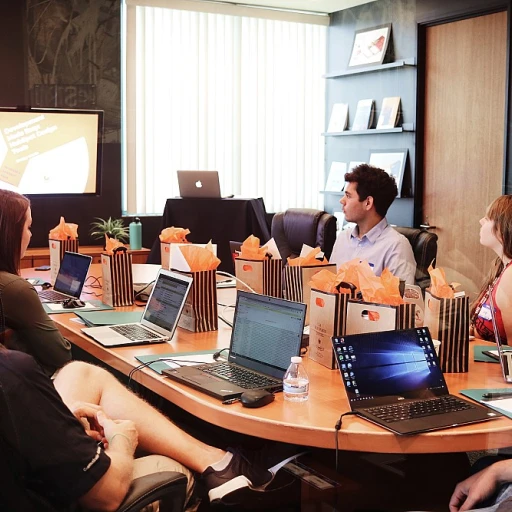
Understanding Skills-Based Hiring
Unveiling the Dynamics of Skills-Based Hiring
Skills-based hiring is shifting the focus from traditional degree requirements to a more nuanced understanding of a candidate's abilities. This approach emphasizes identifying specific skills needed for a role, rather than relying solely on educational background. By doing so, companies aim to fill roles more effectively, sourcing talent that meets job requirements directly.
Employers are increasingly adopting this method to streamline their talent acquisition processes. This is particularly evident in tech-driven industries where job descriptions clearly outline the soft skills and technical expertise required. In these environments, hiring managers seek candidates who demonstrate proficiency through practical assessments rather than just a resume listing.
The benefits of skills-based hiring extend beyond just meeting workforce needs. It allows organizations to tap into a broader pool of candidates and ensures they have the top talent necessary to stay competitive. Companies are finding that this approach not only reduces the time to hire but also enhances the quality of employment outcomes.
Incorporating effective hiring practices that prioritize candidates' skills over degree credentials can also benefit the public sector. Job postings in this domain can tailor specific skills hiring to attract and identify the right talent needed for various roles.
As organizations continue to hone in on skills-based strategies, reskilling becomes a critical component for both employees and employers. Reskilling empowers the existing workforce to meet evolving job market demands and supports career advancement in dynamic fields. For insights on leveraging skills in emerging sectors, explore the path to a career in AI.
The Role of Reskilling in Today's Job Market
The Resurgence of Reskilling
The ever-evolving landscape of the job market demands a focus on skills rather than traditional degree requirements. This shift is particularly relevant as companies seek to adapt to rapidly changing industry standards and technological advancements. The role of reskilling has become central in helping both employers and candidates navigate these changes. Reskilling is the process of training individuals to acquire new skills that align with current job market demands. As employers increasingly prioritize skills-based hiring practices, they recognize that degrees are no longer the sole indicator of a candidate's potential. Instead, they focus on the skills that can drive business success.Aligning Workforce with Industry Needs
In the current state, companies are placing greater emphasis on tailoring their workforce to meet specific roles and skills requirements. This approach not only aids in talent management but also supports employers in acquiring top talent without the constraints of traditional hiring practices. By reskilling, candidates can better fill roles that are essential for organizational growth. Reskilling practices are proving especially significant in industries that are experiencing rapid transformation. From the tech sector to the public sector, there is a need for employees who possess the right mix of technical and soft skills to thrive in their roles. This need has led to comprehensive assessments and training programs designed to keep the workforce competitive and ready for any shift in job requirements.Benefits for Employers and Candidates
For employers, adopting reskilling strategies contributes to reducing time-to-hire by cultivating internal talent pools. This not only accelerates the hiring process but ensures a seamless integration of employees into their new roles. Employers who invest in reskilling also build a culture of continuous learning and adaptability, further enhancing their competitive edge. Candidates, on the other hand, benefit from increased opportunities to enter roles they might have previously been ineligible for based on degree requirements alone. Reskilling opens pathways to career advancement and ensures that individuals remain relevant in a dynamic job market, ultimately leading to more fulfilling work experiences. By embracing reskilling as a cornerstone of skills hiring, companies and candidates alike can position themselves for sustained success. To gain further insights into the ongoing challenges in workforce development, visit Understanding the Challenges in Workforce Development.Challenges in Reskilling for Skills-Based Hiring
Challenges to Tackle in Reskilling Programs
With the increasing emphasis on skills-based hiring, reskilling has become a critical process for workers intending to keep up with the evolving job market. However, the transition to skills-based assessments and training schemes comes with its own set of challenges. Employers and candidates alike must navigate this complex landscape to align with modern hiring practices.
One significant hurdle in reskilling is bridging the gap between current skills and employer expectations. Job openings often list proficiency in new technologies or abilities not previously required, necessitating continual education and training. For companies, this means investing resources in upskilling their workforce or seeking external partners to aid in this transformation.
Cost considerations also play a role in reskilling, especially for smaller companies or public sector organizations with limited budgets. Implementing effective reskilling programs can be resource-intensive, requiring financial investment not only in educational content but also in training facilitation. Without adequate funding, such initiatives may fall short of equipping employees with the necessary skills to fill new roles effectively.
Employers must also address the challenge of matching training programs with real-time job requirements. This requires a symbiosis between employers, educators, and employees to ensure the relevance of training curricula to industry needs. Additionally, soft skills, often overshadowed by technical abilities, are crucial in enhancing candidates' adaptability and performance within their roles. Soft skills training should, therefore, remain a priority within reskilling programs.
Finally, the attitudes and readiness of the employees themselves significantly impact the success of reskilling efforts. Employees may resist change due to uncertainty about the future or fear of inadequate performance in new roles. Encouraging a culture of lifelong learning and providing support can alleviate these concerns, fostering a more adaptable and capable workforce.
For more detailed guidance on overcoming these challenges, consider advancing your career through skill-forward strategies. Empowering employees through comprehensive reskilling will ultimately drive more effective skills-based hiring, creating a mutually beneficial scenario for all stakeholders involved.
Effective Strategies for Reskilling
Key Approaches for Effective Workforce Reskilling
As skills-based hiring continues to gain traction, effectively reskilling the workforce has become essential for both candidates and employers. This need is addressed by adopting a structured approach towards developing relevant skills. Below are some strategies that companies can implement to optimize their reskilling processes:
- Customized Training Programs: To align with the requirements of specific roles, employers can design tailored training initiatives that focus on bridging the skills gap. This allows candidates to acquire both technical and soft skills essential for their target positions.
- Leveraging Online Learning Platforms: Companies can collaborate with online educational providers to offer courses that match job requirements. The flexibility of e-learning platforms enables employees to upskill without disrupting their current work commitments.
- Partnerships with Educational Institutions: By working closely with universities and vocational schools, organizations can stay updated with the latest industry needs and prepare degree programs or certifications that are more aligned with current employer demands.
- Competency Assessments: Conducting regular skills assessments helps in identifying precise areas where employees need improvement. This focused reskilling ensures that companies can tailor the programs based on the strengths and deficiencies highlighted during these assessments.
- Internal Mobility and Job Rotation: By allowing employees to experience different roles within the organization, they can develop diverse skills that enhance their versatility and adaptability. This practice also aids in talent retention by providing a comprehensive career path.
The goal of reskilling efforts should be to create a dynamic workforce capable of adapting to evolving job market demands. With employers increasingly valuing practical expertise over traditional degree requirements, these strategies create a robust framework for both immediate and future talent needs. Effective reskilling not only prepares employees to fill crucial positions but also supports their personal career advancement.
Case Studies: Success Stories in Reskilling
Real-world Examples of Reskilling Success
Reskilling has become an indispensable component of skills-based hiring, especially as employers seek innovative ways to bridge the gap between existing employee capabilities and evolving job requirements. The success of reskilling initiatives underscores the potential for transforming the job market's overall landscape. One prominent example involves a tech company's collaboration with a local community college to reskill its workforce in cloud computing and cybersecurity. Recognizing the increased demand for employees with digital skills, the company implemented a comprehensive training program that brought its employees up to speed with current industry requirements. This strategic move not only filled critical roles within the company but also enhanced employee motivation and retention by investing in their personal growth. Similarly, a large retail chain adapted its hiring practices by eliminating strict degree requirements for managerial positions and emphasizing soft skills alongside specific technical expertise. By recognizing potential in its existing staff and offering targeted developmental programs, the retailer successfully promoted internal candidates with high potential into key roles, which proved both cost-effective and advantageous for talent management. Government bodies too have made strides, particularly in the public sector, where many states are actively building competencies in emerging fields. Through public-private partnerships, they've been able to equip their workforce with the necessary skills to meet future demands effectively. These success stories highlight a common theme: investing in reskilling not only equips employees to adapt to new roles, but also enriches the overall talent pool by promoting a culture of continuous learning. Employers and candidates alike, who engage in such practices, have consistently demonstrated an enhanced ability to meet job market demands and acquire top talent swiftly.Future Outlook: Skills-Based Hiring and Reskilling
The Evolving Landscape of Skills-Based Hiring and Reskilling
The job market is witnessing a seismic shift as more employers prioritize skills over traditional degree requirements. This trend is having a profound impact on hiring practices across industries. As companies and hiring managers advance towards skills-based assessments, the emphasis is increasingly on candidates' skills rather than their academic credentials. Reskilling is emerging as a cornerstone in talent management strategies, enabling employees to meet evolving job requirements. Companies are investing in reskilling programs to fill roles, especially in tech and public sector spaces where digital literacy and adaptive capabilities are crucial. By focusing on reskilling, organizations not only enhance their talent pool but also support their current workforce in transitioning to new positions.Key Drivers and Influences
Several factors are driving this shift towards a skills-based hiring process:- Changing Work Environments: Rapid technological advancements require employees to constantly update their skills to ensure efficiency and innovation in their roles.
- Talent Acquisition Strategies: Employers are restructuring their talent acquisition frameworks to emphasize the skills most relevant to their industry and organizational needs.
- Economic Shifts: The demand for top talent is rising as businesses seek to remain competitive by aligning their workforces with the latest industry standards.













